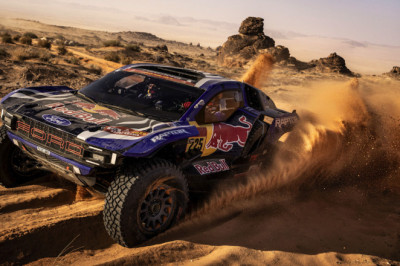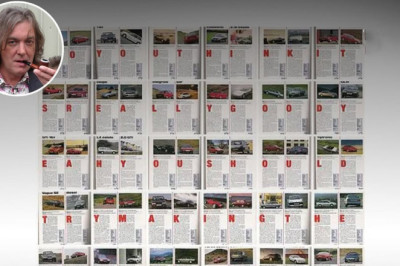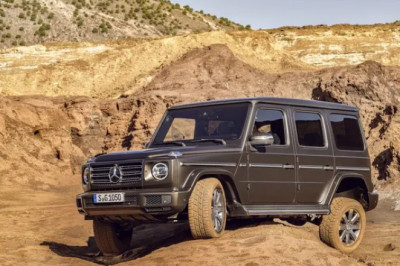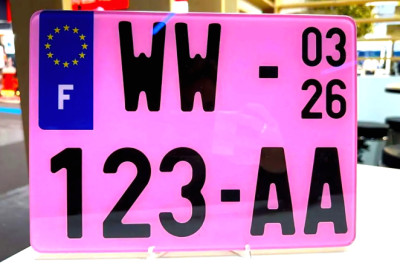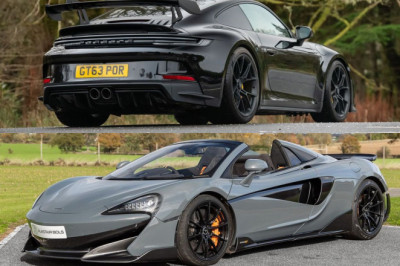
The CX-90 takes on the European establishment with an inline-six and a new rear-drive platform.
The Wall Street Journal told us in early June that America's birth rate was falling, with 15 percent fewer births in 2022 than in 2007. In addition, our fertility rate is hovering at less than half the peak of the late '50s. But that hasn't affected sales of three-row mid-size SUVs—the modern family's substitute for the unfashionable minivan—with sales running at an annual rate of more than 1.3 million units. Of course, the mid-size category, once defined by a maximum length of 200 inches, is being stretched like our collective waistlines.
Consider this all-new Mazda CX-90, which replaces the CX-9 as the largest machine in Mazda's lineup. It measures 200.8 inches long—an inch and a half longer than its predecessor, and longer than the Honda Pilot, the Hyundai Palisade, and the Ford Explorer. But this doesn't translate to huge interior space.
Yes, the CX-90 is a bit roomier than the CX-9, with 143 cubic feet of calculated interior volume—an increase of about eight cubes. But it's 10 to 12 cubic feet smaller inside than its aforementioned competitors. That's not to say the inside is tight. This remains a spacious cabin in the first and second rows, with a third row suitable mostly for kids. But the width is generally a little smaller everywhere than in the competition.
It's interesting that despite the CX-90's 122.8-inch wheelbase—the longest in the segment—legroom is another area where it falls behind. This might be partially because the CX-90 has shifted from the transverse-engine, front-drive-based layout common to most of its competitors to a classic north-south rear-drive configuration. Power comes from Mazda's brand-new 3.3-liter inline-six engine, a very BMW-esque setup.
The engine employs a single turbo and is available in two forms: tuned for regular or premium fuel. Our test example was the more powerful S model, developing 340 ponies at 6000 rpm and 369 pound-feet of torque at 2000 rpm on premium (output falls slightly on regular, but still remains higher than the non-S version's 280 horsepower). It's coupled to a brand-new eight-speed automatic developed by Mazda and bolstered by a 48-volt hybrid system that doesn't increase peak output but can assist the engine with as much as 113 lb-ft of torque at low rpm, primarily when starting from rest.
This all sounds very sporty, but we timed the CX-90 to 60 mph in 6.3 seconds and through the quarter-mile in 14.7 seconds at 99 mph. That's plenty quick enough for family use, but only a tenth quicker in each measure than the 291-hp Hyundai Palisade—and slower than the 300-hp Ford Explorer. Even more surprising, despite the Mazda engine's generous torque and the hybrid boost, the CX-90 is just average in the 30-to-50-mph and 50-to-70-mph intervals, which measure responsiveness in everyday driving. And while the six-cylinder is smooth and quiet in casual driving, full throttle raises the volume considerably but without producing the melodious growl we've come to expect from sporty and powerful inline-sixes.
Some of this lack of midrange punch might be blamed on the wet clutch that replaces the torque converter used in most automatic transmissions. This change is perhaps responsible for helping with the CX-90's stellar fuel economy. The EPA ratings for the S model are 23 mpg city, 28 highway, and 25 combined. Most competitors trail by 4 or 5 mpg in the combined rating. And these numbers apply to the real world, as our car achieved 29 mpg—1 mpg higher than the EPA number—on our 75-mph highway test.
Of course, Mazdas are usually known for their above-average driving dynamics. We expected a lot from the CX-90 in this regard, because the machine enjoys a control-arm front suspension and more balanced front-to-rear weight distribution than the typical front-drive-based SUV. At city speeds the steering provides good feel, but at highway speeds it becomes heavy, making the CX-90 seem larger than it is. Handling and stability are decent but not special, and cornering grip of 0.85 g is only slightly better than the class average. The 70-mph stopping distance of 177 feet is, again, only average. And with this model's 21-inch wheels and tires, the ride was flinty on rough pavement, even with only three people and three heavy bags aboard.
Inside, the styling is handsome, but not all of the materials drew praise. In our top-of-the-line Premium Plus–package version, the tan nappa-leather upholstery is accompanied by large swatches of tan suede on the dashboard face. A more subdued design with a less colorful interior is also available.
What we did like was a full set of HVAC controls above the center console, so we didn't have to explore the depths of the screen menus to change the temperature. In general, the infotainment system works pretty well, controlled by either touch or with a rotary controller on the console. However, one thing odd about the HVAC controls was the pair of toggles used to raise and lower the temperature setting for either side of the front cabin. Pressing the blue one down lowered the temperature, but pressing the red one down raised the temperature. A single toggle with both up and down motions would have been simpler, easier, and more logical.
Although base CX-90s start at $40,970, our fully equipped CX-90 stickered at $61,920, which is about $8000 more than a loaded Hyundai Palisade and over $7000 more than a top-shelf Kia Telluride. Mazda is trying to push into the premium sphere with its new models, and in fully loaded Premium Plus guise, the CX-90 packs a lot of features and hardware. But the CX-90's highest trim costs more than our favorite three-row SUVs in their priciest spec, leaving us wondering whether the top-shelf CX-90 can leap over those less expensive competitors. We'll have an answer as soon as we assemble the segment for a comparison test.
Specifications
Specifications
2024 Mazda CX-90 Turbo S AWD
Vehicle Type: front-engine, all-wheel-drive, 6-passenger, four-door wagon
PRICE
Base/As Tested: $53,125/$61,920
Options: Premium Plus package (quilted-leather seats, heated second-row seats, suede interior trim, second-row captain's chairs with center console, 360-degree camera view, AC power outlet), $8200; Artisan Red paint, $595
ENGINE
turbocharged and intercooled DOHC 24-valve inline-6, aluminum block and head, direct fuel injection
Displacement: 200 in3, 3283 cm3
Power: 340 hp @ 6000 rpm
Torque: 369 lb-ft @ 2000 rpm
TRANSMISSION
8-speed automatic
CHASSIS
Suspension, F/R: control arms/multilink
Brakes, F/R: 13.7-in vented disc/13.8-in vented disc
Tires: Falken Ziex LT60a A/S
275/45R-21 107W M+S
DIMENSIONS
Wheelbase: 122.8 in
Length: 200.8 in
Width: 78.5 in
Height: 68.2 in
Passenger Volume, F/M/R: 57/51/35 ft3
Cargo Volume, behind F/M/R: 75/40/16 ft3
Curb Weight: 4885 lb
C/D TEST RESULTS
60 mph: 6.3 sec
1/4-Mile: 14.7 sec @ 99 mph
100 mph: 15.1 sec
130 mph: 30.4 sec
Results above omit 1-ft rollout of 0.4 sec.
Rolling Start, 5–60 mph: 6.5 sec
Top Gear, 30–50 mph: 3.6 sec
Top Gear, 50–70 mph: 4.5 sec
Top Speed (gov ltd): 130 mph
Braking, 70–0 mph: 177 ft
Roadholding, 300-ft Skidpad: 0.85 g
C/D FUEL ECONOMY
Observed: 23 mpg
75-mph Highway Driving: 29 mpg
75-mph Highway Range: 560 mi
EPA FUEL ECONOMY
Combined/City/Highway: 25/23/28 mpg
Csaba Csere joined Car and Driver in 1980 and never really left. After serving as Technical Editor and Director, he was Editor-in-Chief from 1993 until his retirement from active duty in 2008. He continues to dabble in automotive journalism and LeMons racing, as well as ministering to his 1965 Jaguar E-type, 2017 Porsche 911, and trio of motorcycles—when not skiing or hiking near his home in Colorado.
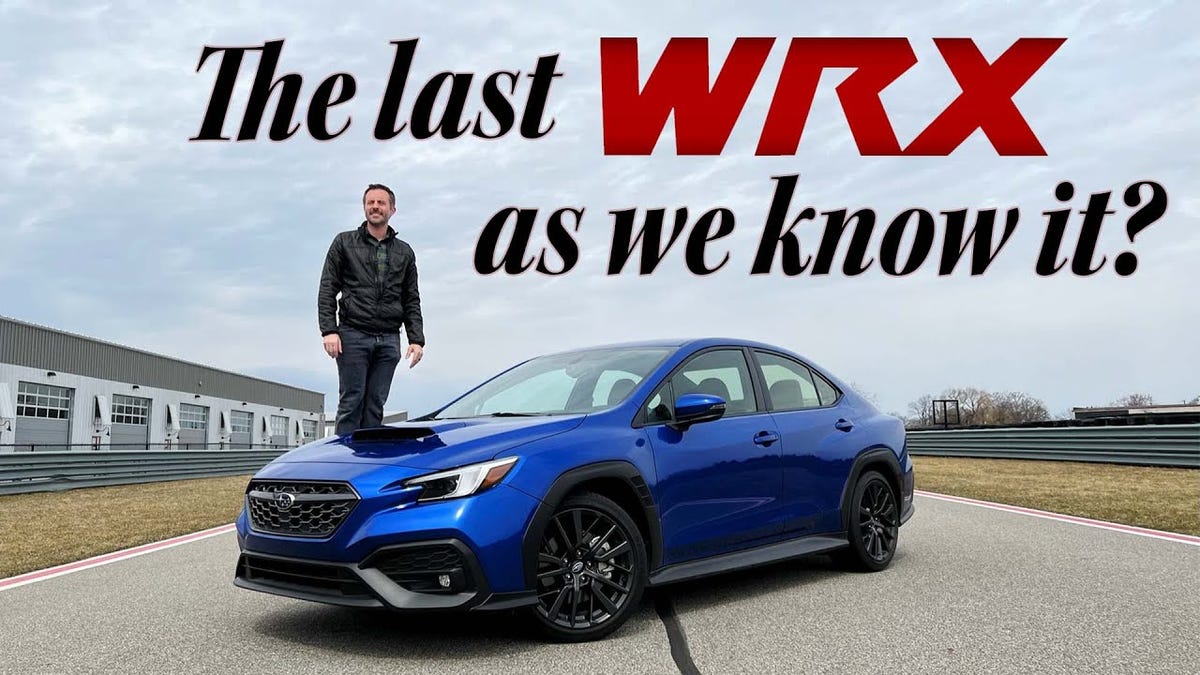
Reviews
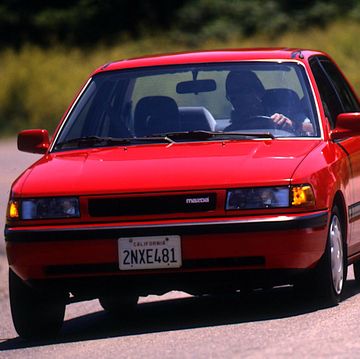
Tested: 1991 Mazda Protegé LX Is a Screaming Deal
2024 Chevy Silverado EV 4WT Gets to Work
Fast-Lane Foreigners: 1991 Sports Sedan Comparison
2024 Hyundai Ioniq 5 N Is Mind-Altering on a Track
2023 BMW X3 M Competition Tested: Ritzy, Racy, Raw
Tested: 2023 Jeep Compass 4x4 Picks Up the Pace
2024 Mercedes-Benz GLC Coupe Hits a Growth Spurt
Ford’s 2023 Super Duty Is a More Modern Work Truck
740-HP Bentley Batur Is Made of Pure Unobtainium
1992 Lexus SC400 Marked a Major Departure
2024 Acura Integra Type S: Same Punch, More Polish
From the Archive: 1991 Isuzu Rodeo Needs Horses
A Part of Hearst Digital Media
We may earn a commission for purchases made through our links.
©2023 Hearst Autos, Inc. All Rights Reserved.
Csaba Csere joined Car and Driver in 1980 and never really left. After serving as Technical Editor and Director, he was Editor-in-Chief from 1993 until his retirement from active duty in 2008. He continues to dabble in automotive journalism and LeMons racing, as well as ministering to his 1965 Jaguar E-type, 2017 Porsche 911, and trio of motorcycles—when not skiing or hiking near his home in Colorado.







